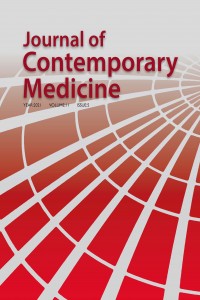Abstract
Amaç: Bu çalışmada amacımız, Gerçek Zamanlı Polimeraz Zincir Reaksiyonu (RT-PCR) pozitif olup bilgisayarlı tomografi (BT) -pozitif COVID-19 hastalarının ve BT-negatif COVID-19 hastalarının C-reaktif protein/Albümin oranı (CAO) değerlerini tespit etmek ve RT-PCR pozitif hastalarının C-reaktif protein/Albümin oranı ile radyolojik görüntüleri arasındaki ilişkiyi araştırmaktır.
Gereç ve Yöntemler: Çalışmamıza 18 yaş üstü 100 RT-PCR pozitif COVID-19’lu hasta dahil edildi. C-reaktif protein (CRP), albümin seviyeleri, diğer veriler ve akciğer BT taraması toplandı. Hastalar iki bölüme ayrıldı: BT-pozitif ve BT-negatif. Komorbidite dışlanmadan ve dışlanarak CAO ve BT taraması arasındaki ilişkiyi araştırdık.
Bulgular: BT pozitif grupta ölçülen CRP seviyeleri ve CAO değerleri, BT negatif gruba göre anlamlı olarak yüksekti (CRP:37.76 ± 64, 9.05 ± 22, p <0.05, CAO:11.8 ± 23.2, 2.12 ± 5.42, p <0.05). Ölçülen albümin seviyeleri BT-pozitif grubu, BT negatif gruba göre anlamlı derecede düşüktü (4.12±0.63, 4.53±0.36, p <0.05). Komorbiditesi olmayan hastaları değerlendirdiğimizde; BT-pozitif grupta ölçülen CRP seviyeleri ve CAO, BT-negatif gruba göre anlamlı olarak yüksekti (15.94 ± 19.2, 6.07 ± 7.38, p <0.05, 4.57 ± 6.82, 1.38 ± 1.75, p <0.05). BT-pozitif hastaların albümin değerleri BT-negatif hastalarınkinden daha düşük olmasına rağmen, istatistiksel olarak anlamlı bulunmamıştır.
Sonuç: Genel olarak CAO düzeylerini BT-pozitif hastalarda, BT-negatif hastalara göre anlamlı olarak yüksek bulduk. Ancak komorbiditeyi dışladığımızda C-reaktif protein/albümin oranının azaldığını da göz önünde bulundurmak gerekir. BT'nin kontrendike olduğu durumlarda (gebelik gibi) akciğer tutulumunu göstermek veya akciğer tutulumu olan hastalarda parankimal tutulumda olası artışı göstermek için öncü bir belirteç olarak kullanılabileceği düşünülebilir.
Supporting Institution
Bu Çalışma herhangi bir kurum tarafından finansal olarak desteklenmedi
Thanks
Bu çalışma Şanlıurfa Eğitim ve Araştırma Hastanesi'nde yapılmıştır. Yazarlar Şanlıurfa Şanlıurfa Eğitim ve Araştırma Hastanesi'ne teşekkürlerini sunarlar.
References
- Referans1 Xu Z, Shi L, Wang Y, Zhang J, Huang L, Zhang C, et al. Pathological findings of COVID-19 associated with acute respiratory distress syndrome. Lancet Respir Med 2020;8:420–2. [CrossRef]
- Referans2 Wang G, Wu C, Zhang Q, et al. C-reactive protein level may predict the risk of COVID-19 aggravation. Open Forum Infect Dis. 2020;7(5): ofaa153. https://doi.org/10.1093/ofid/ofaa153.
The relationship between C-reactive protein/albumin ratio and radiological findings in patients with COVID-19
Abstract
Aim: Our aim in this study is to determine the C-reactive protein/Albumin ratio (CAR) values of computed tomography (CT) -positive COVID-19 patients and CT-negative COVID-19 patients who are Real-Time Polymerase Chain Reaction (RT-PCR) and to investigate the relationship between C-reactive protein / Albumin ratio and radiological images of RT-PCR positive patients.
Material and Methods: 100 RT-PCR positive COVID-19 patients over the age of 18 were included in our study. C-reactive protein (CRP), albumin levels, other data and lung CT scan were collected. The patients were divided into two sections: CT-positive and CT-negative. The relationship between CT and CAR was investigated in patients with and excluding comorbidity.
Results: The measured CRP levels and CAR in the CT-positive group were significantly higher than CT-negative group (37.76±64, 9.05±22, p <0.05, 11.8±23.2, 2.12±5.42, p <0.05). The measured albumin levels CT-positive group were significantly lower than CT-negative group (4.12±0.63, 4.53±0.36, p <0.05). When we evaluate patients without comorbidity the measured CRP levels and CAR in the CT-positive group were significantly higher than CT-negative group (15.94±19.2, 6.07±7.38, p <0.05, 4.57±6.82, 1.38±1.75, p <0.05). Although the albumin values of CT-positive patients were lower than those of CT-negative patients, no statistically significance was found.
Conclusion: In general, we found that CAR levels in CT-positive patients were significantly higher than in CT-negative patients. However, when we exclude the comorbidity, it should be taken into account that the ratio of C-reactive protein/albumin decreases. It can be considered that CT can be used as a leading marker to show lung involvement in cases where it is contraindicated (such as pregnancy) or to show possible increase in parenchymal involvement in patients with lung involvement.
References
- Referans1 Xu Z, Shi L, Wang Y, Zhang J, Huang L, Zhang C, et al. Pathological findings of COVID-19 associated with acute respiratory distress syndrome. Lancet Respir Med 2020;8:420–2. [CrossRef]
- Referans2 Wang G, Wu C, Zhang Q, et al. C-reactive protein level may predict the risk of COVID-19 aggravation. Open Forum Infect Dis. 2020;7(5): ofaa153. https://doi.org/10.1093/ofid/ofaa153.
Details
| Primary Language | English |
|---|---|
| Subjects | Health Care Administration |
| Journal Section | Original Research |
| Authors | |
| Publication Date | September 17, 2021 |
| Acceptance Date | May 26, 2021 |
| Published in Issue | Year 2021 Volume: 11 Issue: 5 |


